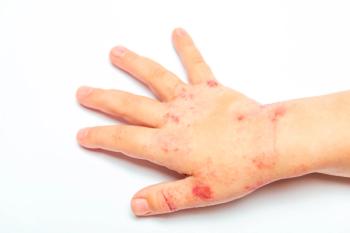
Congenital Dermal Melanosis
This fairly common phenomenon, also known as Mongolian spots, affects more than 90% of African Americans, 80% of Asians, 46% of Hispanics, and fewer than 10% of Caucasians.1 The bluish gray or slate-colored areas occur most frequently on the lower back and buttocks and less frequently on the posterior thighs, legs, back, and shoulders. The face is rarely affected. The skin coloration is believed to be caused by melanocyte migration arrest from the neural crest to the epidermis.
Figure
FigureThe bluish gray skin coloration of the left upper extremity, including the thumb and middle finger, and on the right buttock in a full-term, African American, newborn girl is congenital dermal melanosis.
This fairly common phenomenon, also known as Mongolian spots, affects more than 90% of African Americans, 80% of Asians, 46% of Hispanics, and fewer than 10% of Caucasians.1 The bluish gray or slate-colored areas occur most frequently on the lower back and buttocks and less frequently on the posterior thighs, legs, back, and shoulders. The face is rarely affected. The skin coloration is believed to be caused by melanocyte migration arrest from the neural crest to the epidermis.
In most cases, no treatment is necessary. Parents can be reassured that the condition is benign and that the affected areas (particularly in persons with dark skin) tend to fade or blend in with skin hyperpigmentation that increases naturally within the first few months or years of life. The pigmentation of less commonly involved areas is less likely to fade over time.2 Malignant degeneration has not been reported.1
Of chief concern is the possible misdiagnosis of bruising in the infant or child with these lesions, which can lead to allegations or suspicion of child abuse. It is important to document (with photographs at birth and/or other methods) the location, size, and shape of congenital dermal melanosis when observed in newborn babies to prevent wrongful accusations of caregivers.
Newsletter
Access practical, evidence-based guidance to support better care for our youngest patients. Join our email list for the latest clinical updates.








